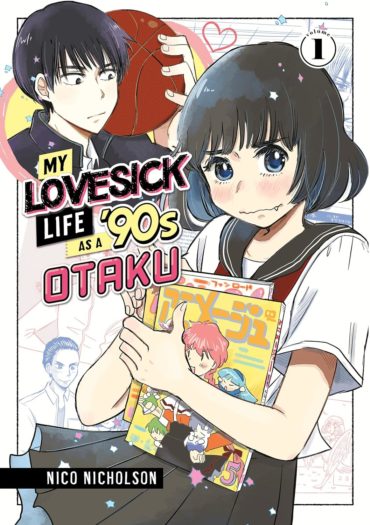My Lovesick Life as a ’90s Otaku Volume 1 Review
Nostalgia and fandom are both powerful things. Put it this way: while you should not judge a book by its cover, I do admit that part of the reason I was drawn to reviewing this manga was indeed the cover. “The girl on the front is holding a magazine featuring CLAMP’s Magic Knight Rayearth? I wrote a book all about CLAMP, thus I’m reading this!” I can confirm that I was right to read this, as My Lovesick Life as a ‘90s Otaku is a fun read.
The otaku in question is Megumi Sato, a 42-year-old divorced single mother to 16-year-old daughter Sakura, who is proud to show off her love of anime and manga in 2021. This is something Megumi could never have done as a teenager, as we see with the story told in flashback.
Back in 1995, when Megumi was 17, she transferred to a new school. At the time, otaku were stereotyped as lonely, loveless freaks and potential criminals. This was not surprising, given the scandals that had happened years before. In the late 1980s there was the case of serial killer Tsutomu Miyazaki, the “otaku murderer”, which led to a moral panic about otaku which lasted for years. In 1991 there was the anime Otaku no Video, a “have your cake and eat it” celebration and mockery of otaku culture that was released by Gainax.
Anyway, Megumi has decided not to reveal any of her otaku interests for fear of being ridiculed. While her introduction to the class is awkward, she is made more comfortable by the class president Masamune Kaji, a guy with a “yankii” delinquent look, but when he plays basketball he looks just like one of Megumi’s favourite manga characters, Kaede Rukawa from Slam Dunk. When Masamune gives Megumi a lift home after school, Megumi begins to fall in love with him, but Masamune says he despises otaku, so she has to do her best to hide her nerdy passions from him.
As the story progresses, we witness Megumi interacting with other people. One is an otaku pen pal whom she believes to be a girl called Yui, but is actually a boy named Itokichi, whose parents are in the Self Defence Force and are keen for him to follow in their footsteps. Another is a fellow classmate, Michiko “Miko” Okochi, an out-and-proud otaku who at one point threatens to expose Megumi’s geekiness, but in the end relents on the condition that they work on a doujinshi together. As this volume progresses, we begin to witness what looks like the reason for why Masamune appears to hate otaku so much, in that it seems to affect one of his family.
As stated before, the first draw to this manga was the referencing and familiarity with so many classic manga. The nostalgia is comforting. With Magic Knight Rayearth appearing on the cover, CLAMP’s Tokyo Babylon also gets a mention, in a storyline where Megumi is collecting art supplies to help make a flag for Masamune’s basketball team and so contemplates making a bold cover like that of the original Tokyo Babylon manga. With the story being set in 1995, one big series that gets mentioned is the debut of Neon Genesis Evangelion, with Megumi’s hairstyle being compared to that of Rei Ayanami. Many other series get namedropped too, including JoJo’s Bizarre Adventure, Dragonball and (unfortunately given that characters didn’t know what the creator was like at the time) Rurouni Kenshin. All of this in turn leads to the artwork, in that Nico Nicholson is able to accurately recreate many classic anime characters and moments alongside their own creations.
However, as you start reading the story, you are drawn more towards the characters in question, especially Megumi and her panic about being a social outcast for her fondness for anime. This still feels true to a certain extent, especially here in Britain where the reputation of anime and manga was so bad for so long. When I first got into manga, it too took a long time to admit it to anyone, especially family members, and I hid my passion. Nowadays anime and manga is becoming more accepted in Britain, to the point where you can now watch Pokémon on BBC iPlayer, and Studio Ghibli films get nominated for BAFTAs. Part of the reason for wanting to read this manga is seeing how far we have come over the past few decades.
As far as production is concerned, this manga has certainly been well produced. Matt Treyvaud’s translation appears to have no problems. The manga has decided to go with the style of expanding accented letters to make them more phonetic for ease of reading (see “yankii” instead of “yankī”). Jamil Stewart offers a range of lettering styles, differing between spoken speech and Megumi’s internal monologue, as well as using more frantic fonts for when Megumi panics. There are also plenty of translation notes to help with references. This connects to one personal touch early on in the book when editor Maggie Lee writes: “There is no shame in checking them out! Your otaku cred will still be high – in fact, it will increase!!”
My Lovesick Life as a ‘90s Otaku is only four volumes long, so it won’t be long for us to discover how Megumi will finally come to terms with everything in her life. It will hopefully be a fun ride as we progress.
Our review copy from Kodansha was supplied by Diamond Book Distributors UK.


